Frigates Studied
Shtandard
HMS Surprise
Hermione
USS Constitution
HMS Trincomanlee
La Belle Poule
Dom Fernando
HNLMS Bonaire
Birth of a new warship: The Frigate
“Frigates” is a familiar term of naval nomenclature today. With naval technology advances and growth, the type is admitted stuck between two classes: Destroyers and Corvettes. They are in service in all major and secondary navies today, but by their armament and capabilities, they are somewhat close to destroyers in versatility. It was not meant to be. The current definition is coming a long way, which we are going to determine.
Cruisers are the true inheritance of the old concept of a “Frigate”. Essentially light, fast ships able to perform reconnaissance, long range patrols and commerce raiding missions individually, detached from the main battle fleet. Powerfully armed and very fast to be able to survive their equivalent and flee their larger opponents, this is strangely reminiscent of the classic sailing frigates.
However with the arrival of the cruiser, and later the destroyer, Frigates disappeared. The term was resurrected for small ships, larger than corvettes, and sometimes seen as long range ASW specialists. But what is a bit misleading today is that Frigates are largely seen as versatile and as much capable and large as destroyers. This is very clear in the actual FFX program of the US Navy. Would Frigates will eventually replace destroyers in the long run, which themselves eclipsed cruisers ? Or will they find their right place in the modern nomenclature ?. Future will tell.
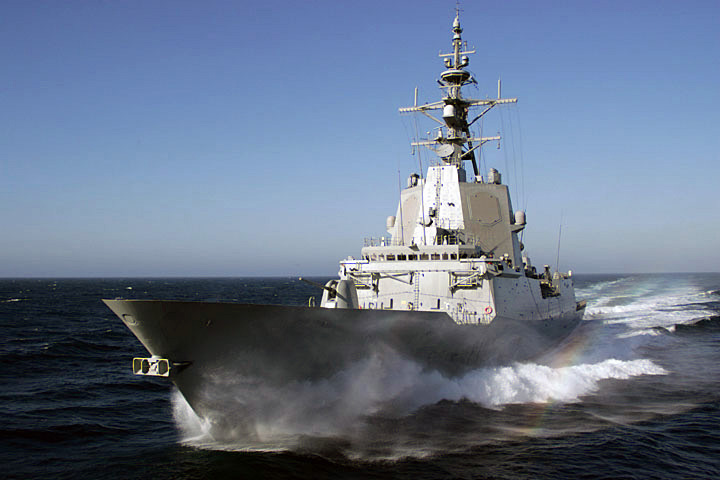
Return of the Frigate in WW2 and the cold war
Wit the enormous diversification and mass production of WW2, the term of “Frigate” was resurrected, applied to British ships, essentially similar to the USN escort destroyers. They were, like corvettes, ASW dedicated ships, but properly military platforms, with longer range and better speed than Corvettes as the latter were often from civilian yards, in particular the minimalist “Flower” class, essentially whalers.
Frigates retook their place in cold war navies in this guise, but on the long run they embraced modularity and specialization. AA frigates started to emerge, and in turn truly versatile ships, “budget destroyers” for small navies that can’t afford proper destroyers.
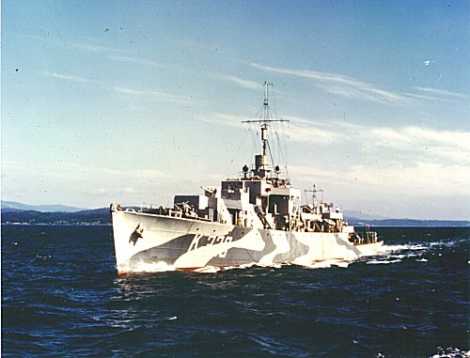
All these theoretical roles does not tell how much the creation of the first frigates represented such a leap forward in naval thinking and shipbuilding, that we are about to see here, going back to the roots:
XVIIth Century Naval Nomenclature
The art of naval warfare was perfected during the era of the first large national fleets with globalist ambitions, in particular, the early XVIIth Century, with the rivalry between France, England and Holland. The Galleon of the past century mutated into the “ship of the line” when the line was adopted as a main tactic to maximise broadside firepower. These ships of the line were later classed by the number of guns, sometimes decks (only covered decks were counted), and sometimes class to make a difference.
The largest were 100+ guns, with three covered decks (four total), but they appeared at the turn of the 18th Century. But the most common were ships of 65-90 guns, sometimes ordered by class, down to the VIth rate. The latter were in general 20-28 guns ships with just one covered deck. Frigates emerged often larger than this, but Corvettes fit into this size. One must understand that classic navies which emerged in the 1600s and practised the battle line tactic were rather monolithic, with three-masted vessels classed by their firepower.
Alongside existed “naval dust”, cutters, fluyts, pinnaces, all sorts of civilian ships used ad hoc, with only the corsairs to drive forward new fast, well-armed types like the brick and hooker, the sloop. The Frigate (and the Corvette which appeared later as a smaller version) were new concepts which tremendous consequences. To find an analogy on land, they represented the cavalry.
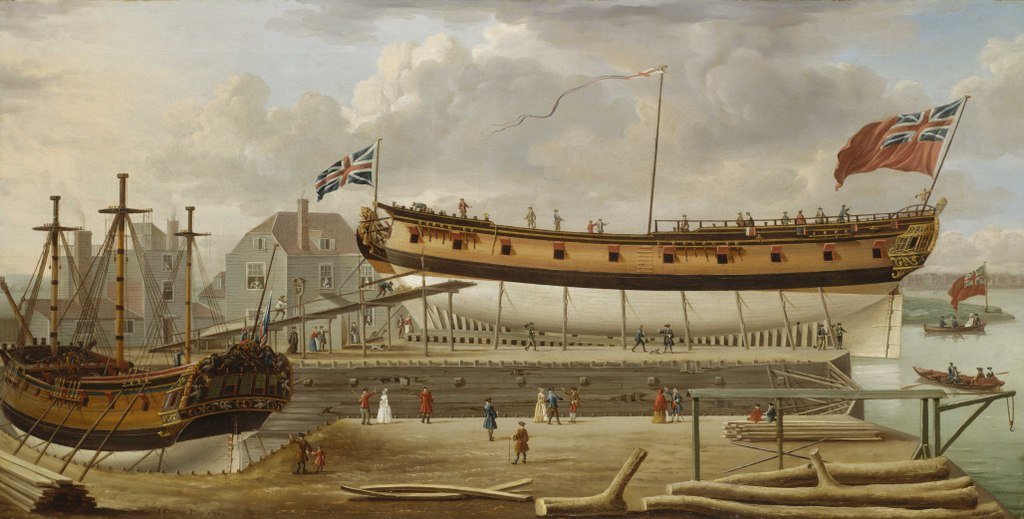
Painting of ‘A Sixth-Rate on the Stocks’ by John Cleveley the Elder. They carried about 150–240 men, measured between 450 and 550 tons. Larger than this and 28 guns was the territory of Frigates. HMS Surprise captained by Jack Aubrey (captured 1796) was centerpiece in Patrick O’Brian’s popular novels. They were large enough to have a post-captain in command but fell in disregard and were phased out, made obsolete by faster and more powerful frigates.
The classic warship at the beginning of 1600 was the “man-o-war”, a tall ship with high forecastles. There was a clear line between these “battle wagons”, slow and ponderous and the “naval dust” constituted by smaller ships used for reconnaissance (Corvettes), supply, or communication between vessels, in alternative to the flag system. The latter were dispatch vessels, called in French “aviso” and kept their subsidiary role in the XIXth century by embracing steam power. But there was definitively nothing in between.
Mediterranean Frigates
Frigates had an ancient and interesting origin. The term itself came from Mediterranean nomenclature for late half-galleys in the XVth Cent. Italian fregata, or Fragatao for the Spanish, Catalan, Portuguese and Sicilians, fregat for the Dutch and Frégate for the French. The term is perhaps a “slang” version of the old Latin “aphractus” or Greek “Aphraktoi” meaning “no deck” to indicate this was a small and light ship or “undefended”.
The term stayed in use later for a new type of ship, at first developed and used by Barbary corsairs and soon adopted by all navies: The Xebec. This was essentially a galley without oars, or only using rows in flat sea and in harbors, but relying on well developed lateen sails on three masts for speed, and using small artillery on her broadsides.
The type was especially popular at the end of the XVIIth century and wit European influence began to shift to the ‘Polacca/Polacre’, mixing square sails woth the same hull. One can argue that the XVth Century Galeasses and following Galleons were the same concept on a larger scale. But the Xebecs were really the “speed boats” of their time, and often were associated with the Frigate, giving the hybrid “Xebec-Frigate”, popular in the late XVIII-XIX Cent when fully squared-rigged.
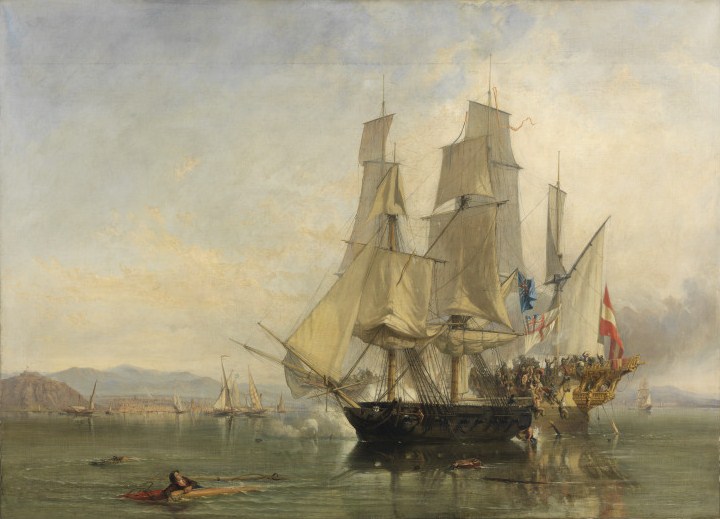
Capture of the Spanish 32-guns Xebec-Frigate El Guamo by Clarkson Frederick Stanfield (1801)
XVIIth Centuries Ocean-Going Frigates
16th Cent. Dunkirkers Corsairs Frigates
The term, and the particular type of galley associated stayed confined into the Mediterranean until the French took over the concept for the Atlantic. The Dunkirkers, privateers from Dunkirk attacking Dutch shipping -then newly independent from Spain. Soon, they used the term of Frégate to describe their ships, and the Dutch were not long to adopt the concept as a counter-measure.
The first warship of the Royal French Navy designated “frigate” dated indeed from 1636: The Princess, probably a Spanish catch of war. The model was studied and copied by the then brand new arsenal of Brest, funded by Richelieu. Similarly in Great Britain, the first ship of this type, the Warwick Frigate, would be a copy of a Dunkirk frigate.
These first frigates were characterized by a short quarter and large poop, displaced about 400 tons and carried a single battery of about ten guns on each side, so they were 20-guns, light 6 or 8-pdr. But from the second half of the century, they received smaller caliber batteries on two decks for around forty guns. They also used often oars stuck between the the lower battery and upper open deck. “Frigates” did not designated either a particular class but was rather an adjective, “fregating”, implying particulars in construction, notably for a low ship. But those used by corsairs, smugglers and larger warships represented the thinnest and agile, fast kind available, racehorse of the seas. Here, the Aurore, a typical French Dunkirk Frigate of the 1650s.
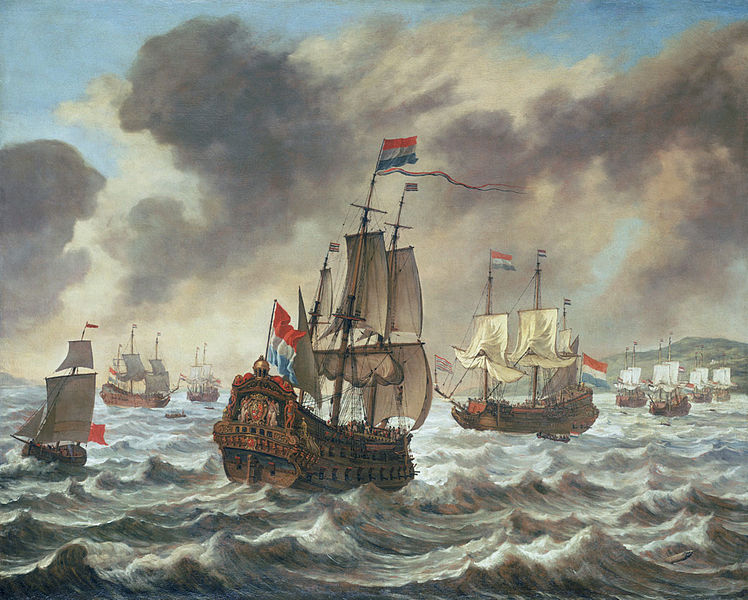
Battle of the Downs, where Dutch shallow-draft frigates played a key role in 1639.
The Dutch Frigates turned the tide
The Dutch Republic indeed as to bring the concept way further, designing larger vessels made for long navigations around the globe, protecting their trade routes against pirates and privateers. They had a better artillery, still fine lines and larger rigging in order to keep pace with thir adversaries. The Dutch already had relatively light hybrid ships such as the Fluyt, but they were way too cumbersome to fit the bill. Another kind of light hybrid that could mirror Frigates for trade was the Pinace, also built by France, Portugal and Spain.
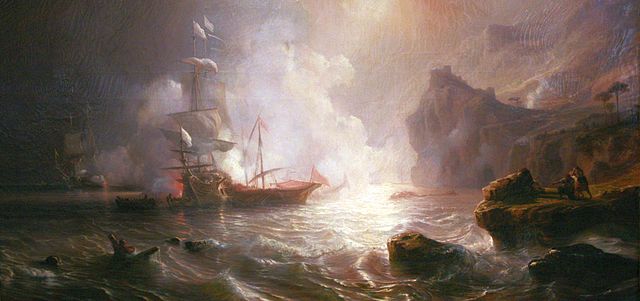
However in a sense, the Spanish own versions of the Fregata inspired a British architect, Matthew Baker, to design his series of Elisabethan “racehorse galleons” which won the day against the Invincible Armada. They were in essence “Frigate Galleons”. But what really spawned interest in Frigates was the newly-born tactical changes of naval fighting in the 16th Century, between the British, French and Dutch. The British were the first to introduce the battle line concept, whereas the Dutch still fought in melee and accumulated defeats.
With Tromp and moreover Michiel de Ruyter, drastic changes are made to the Dutch fleet. The new admiral ship De Zeven Provincien was only the tipping point of a revolution as the Dutch fought in line with a refined signal system, planning feints and moves to incite the enemy to attack where planned. This brings victories time and again. But the newly found rigidity in combat was later a call for faster, more nimble ships still able to fight individually, detached of the main corp, just like on land, the ancient rigid hoplitic system, or the pike and musket formations of the time asked for a faster, more agile infantry, or the cavalry, to come along. Flexibility was required when it was just lost.
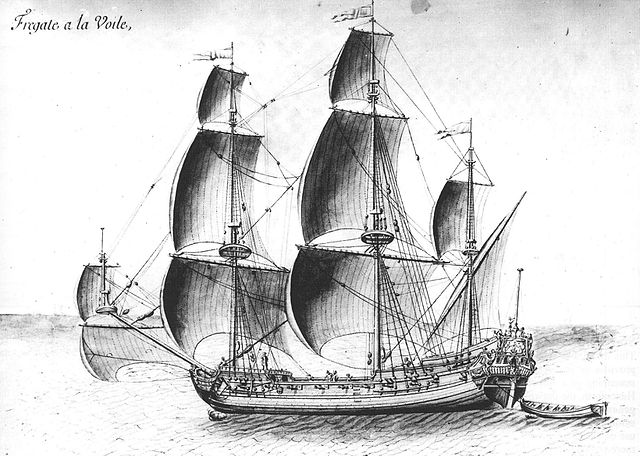
Ocean-going Dutch Frigate of 1670. The type was used for escort but also attacking Spanish trade and blockading ports. They had ample supplies, combined speed and shallowness of draft.
Nevertheless, if the new type was born in Hoorn around 1620, during the Eighty Years’ War, the Dutch definitely exchanged their heavy fleet for Frigates, generally 40-guns 500 ton vessels and their admiral, defeating the Spanish, British and French heavier ships time and again showed their mastery of the type, which flew above sand banks. The Battle of the Downs in 1639 in particular was won by these frigates, convincing British authorities to look after the type more seriously.
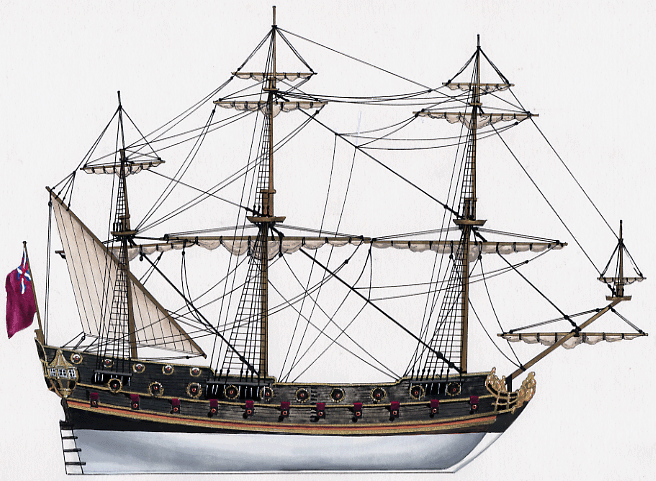
British Frigates during the time of the second Anglo-Dutch wars in 1665-1667. Author’s illustration.
The British started to develop similar “long” vessels of 40 guns then turned their first two-decker “great frigates” of the third rate, 60 guns. Broadside tactics were developed around the hulls of these which were long and narrow. They always were considered as “cruisers” operating independently of the fleet for various tasks. The concept evolved with a twist, reintroducing oars at some point like the HMS Charles Galley of 1676. The type went on with some excesses, until the Royal Navy firmly capped it in the 1800s as single-decked ships of the fifth rate and exceptionally sixth-rate.
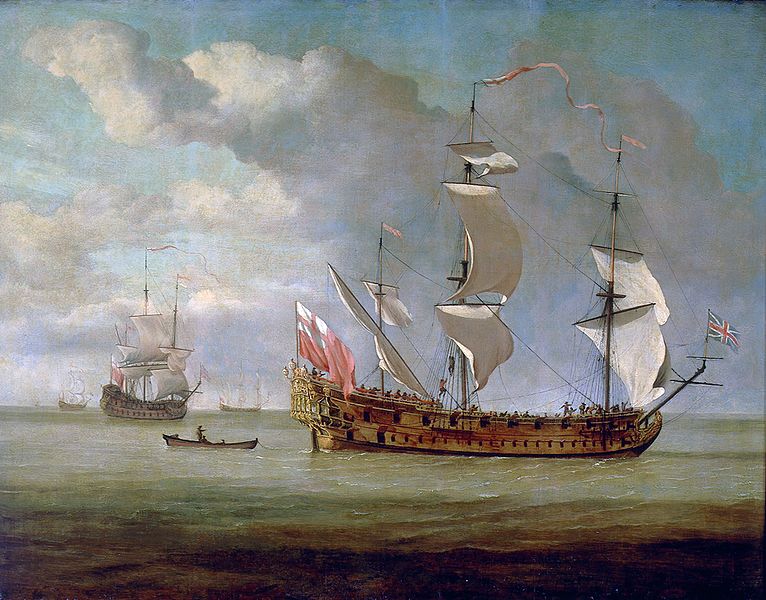
HMS Charles Galley by Willem Van de Velde the Younger (1676), keeping a bank of 40 oars above her battery. The concept was resurrected nearly 100 years later by Frederick af Chapman for the Swedish ships operating in the Baltic shallows (see later).
XVIII-XIXth Centuries ‘Classic’ Frigates
New French Frigates (1740)
The mid-XVIIIth up to the mid-XIXth are generally regarded as the golden age of sailing Frigates. The Napoleonic wars in particular helped redefine the type and the French were keen to develop their own concept, compensating in quality what they lancked in quantities, regarding the already considerable size of the Royal Navy at that time. The French-built Médée (1740) was already such a concept when the French fleet was already equal to the Royal Navy. This vessel was square-rigged (and generously) but overall, carried all the main guns on a single continuous upper deck while the deck below, although often painted with false ports, was devoid of any armament and used for storage and crew, a “berth deck” which went below the waterline.
The upper gun deck was partially armed but the ships were nevertheless somewhat top-heavy.
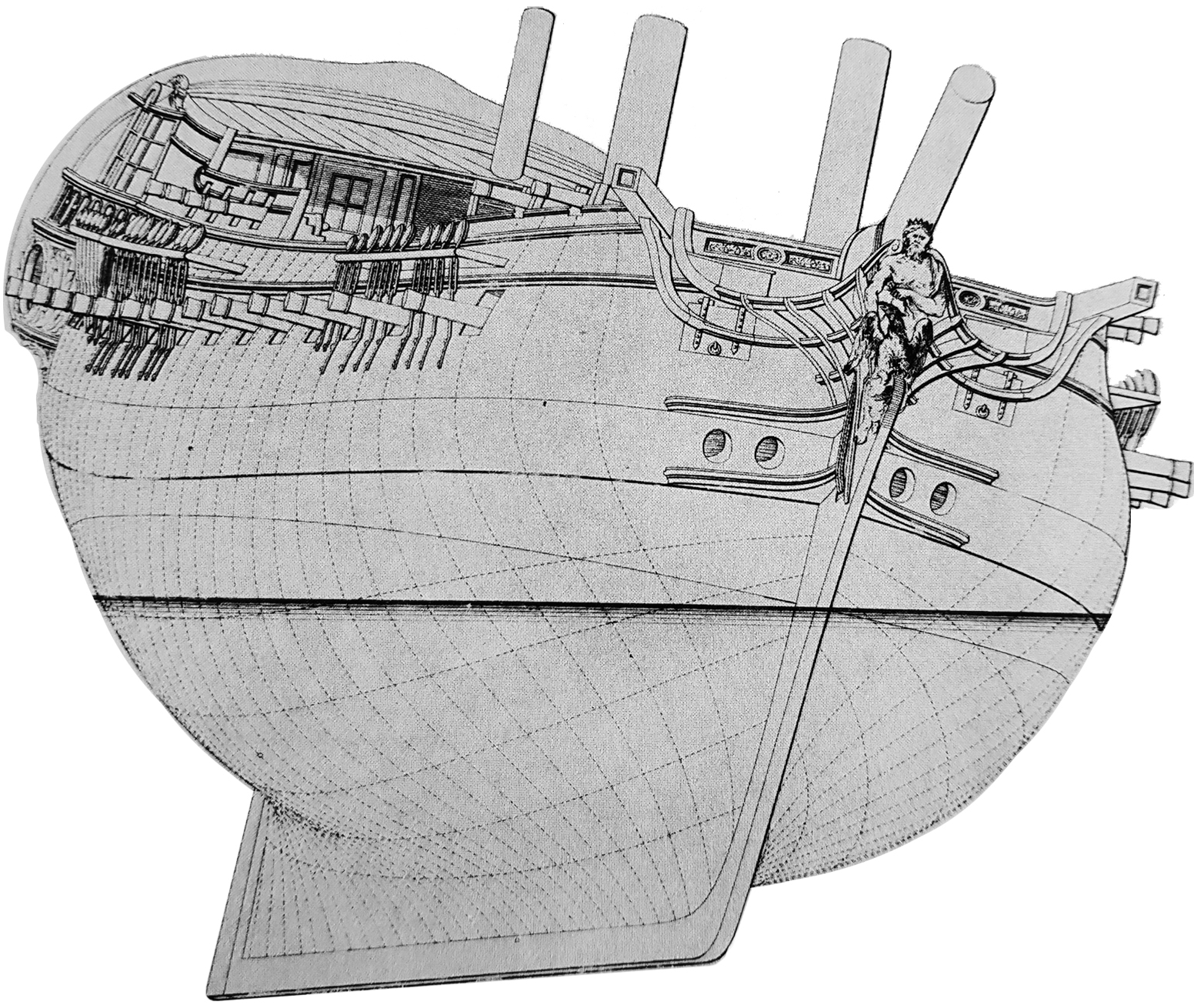
Splendid 3D drawing of naval architect Chapman of a XVIIIth Century Frigate
Fifty-nine of these French sailing frigates were built between 1777 and 1790, all capable of 14 knots thanks to a hull design mahematicaly studied using the first hydrodynamic concepts. The same care is quite evident when seeing architect drawings of the time, like those of Frederick af Chapman. Their perfect execution recalls the first 3D computer renderings. At 47, he published his ultimate achievement, the “architectura navalis mercatoria”, a reference for a century, well aware of the works of Newton and D’Alembert, his numerous exchanges in various shipbuilders of the time around Europe, and Euler’s “Scientia Navalis”, Du Monceau, De Murray. In his numerous remarkably precise drawings we recoignised early frigates such as the French Sirène and British Unicorn. Both were 24-26 guns in one single deck, plus 8-10 4-pdr guns on the aft forecastle.
British Frigates (1747)
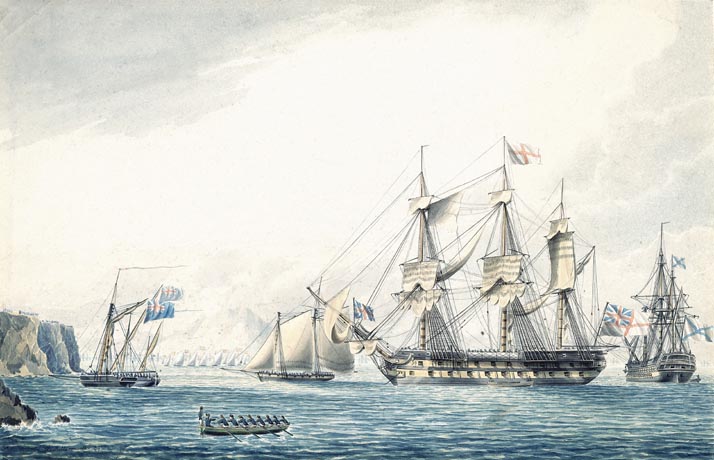
HMS Argo with a Russian ship off Gibraltar. This was a Roebuck class Frigate (1781), part of a twenty-ship group, 44 guns, 5th rate. The 1784 Adventure class was pretty close.
These Frigates, and in particular their inshore handling impressed the British Royal Navy, which captured some during the War of the Austrian Succession (1740–1748).
They were copied, starting in 1747, and after a while, improved. The basic model was 28 guns, fourteen for each broadside, all 9-pounder artillery pieces. There were also four smaller pieces installed on the above open deck, but they were not counted, nor the on-board musketry and grenades used for close combat and boarding. These 28-guns were considered 6th rate, but soon, 5th rate appeared, traduced into 32-36 guns frigates.
They had indeed an upper deck battery of twenty-six 12-pounder guns, and 6-10 smaller ones were carried on the quarter deck and forecastle for chase and retreat. However soon the British admiralty desired a larger model, and in 1778 created a 36 gun frigate (all on the main deck), which added to this were 18-pounder, for a broadside twice as powerful. Over time, the Frenc designed just before the revolution their own 38-guns, 18-pounder version, while the British responded by mass-producing three models, a very large 38-guns, the standard 36-guns and the cost-saving 32-guns. Most saw action during and after the Napoleonic war around the world, preying on trade.
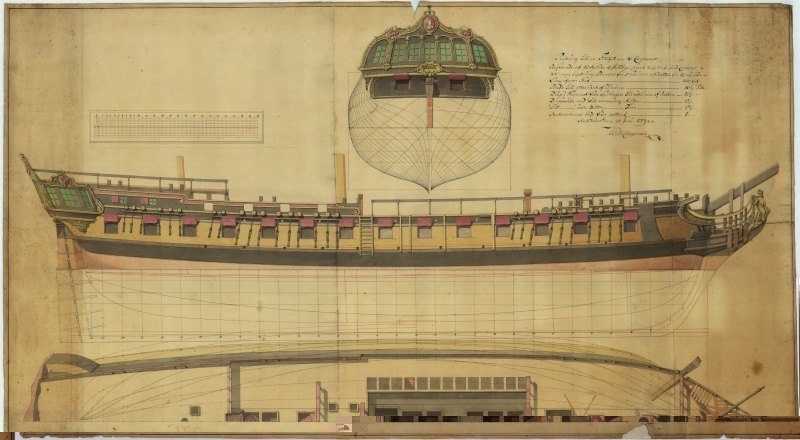
American super Frigates (1797)
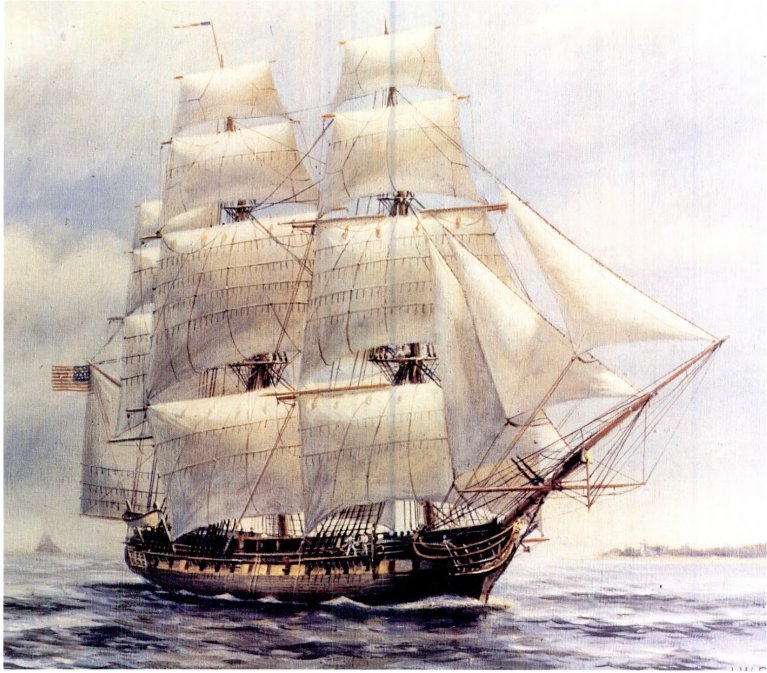
USS Chesapeake
The American Independence of 1775 secured the country’s future in political terms, but at the time this secession from the world’s first power was not without consequences. Without a fleet, and the protection of the Royal Navy, American merchant shipping became easy picking for privateers and pirates. The case was particularly acute in the Mediterranean, from the north African Barbary corsairs. The Congress saw the utility of a fleet of frigates, less frightening than costly ships-of-the line, yet fast and strong enough in all ways to crush any opposition.
However before going into this, during the American revolution already, was built a remarkable 32-gun frigate for the Continental Navy, USS Randolph (1776). She was a “prototype” followed by 12 other Frigates including the USS Hancock, the admirative British sailors described her (after capture as HMS Iris) as the “most superb and fastest ship on earth”. However after the revolutionary war, the Continental Navy was disbanded and the last ship, in a sorry state, USS Alliance, sold in August 1785.

Nearly twenty years after, and long after Thomas Jefferson past lobbying for a navy, the Congress authorized a new class to deal with barbary corsairs, the original six frigates of the United States Navy with the Naval Act of 1794 (March 27, 1794). Indeed, the North African independent kingdoms having difficulties with the well-protected French and British convoys, used to prey on American shipping, undefended. Crews were made prisoners or killed, resold into slavery, the ships looted or ransoms asked for. Compounded by the aftermath of the French revolution and all-out war between UK and France also hitting American trade, President Washington at last secured a decision in the Congress in 1794, by a thin margin (44-46).
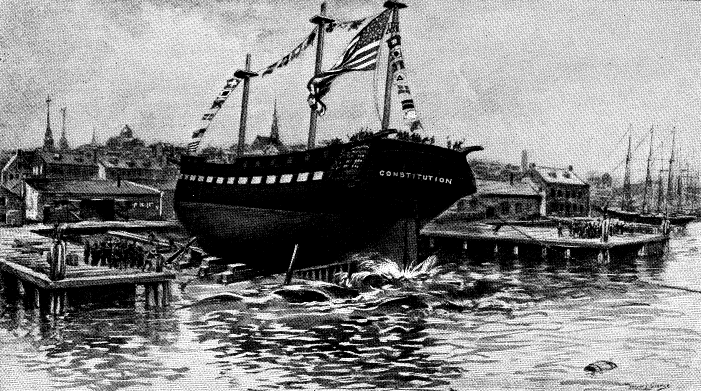
Secretary of War Henry Knox submitted proposals to the committee, and lately the order confirmed the acquisition and equipment of four ships to carry forty-four guns each, and two ships to carry thirty-six guns each. Since there was no Department of the Navy yet, the program fell into Knox’s Department of War. He consulted and assembled all ship architects and shipbuilders in the largest port in the USA then, Philadelphia. The end result, approved by Washington, was large enough to overcome any frigate and fast enough to escape any ship of the line. They were coined “super frigates” but their concept was in essence of early “battlecruisers”.
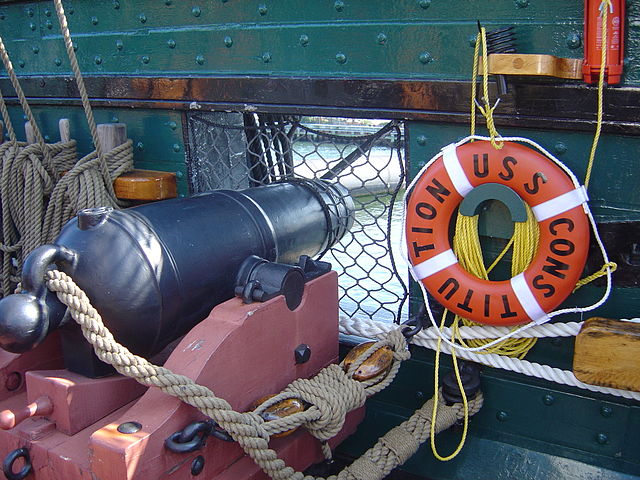
Elite British draftsman, Josiah Fox was hired to draw the final plans, but at the dismay of main architect Humphreys, her made them much smaller than the original. He was removed and Humphreys finalized the plans and made a model of the ship to be presented to Washington and another, half-size, to draw templates and molds. In all there were four 44-guns, USS Chesapeake, Constitution, President, United States and two 36-guns, USS Constellation and Congress. They were built, respectively at Gosport (Virginia), Boston, New York, Philadelphia, Baltimore and Portsmouth (New Hampshire). Particular care was given to the wood choices for the hull, white pine, longleaf pine, white oak, and, and southern live oak, the strongest of all. This was compounded by the very close sections of the ships and wood combinations, making projectiles bounce on the hull instead of piercing it.
The genius of the design also was to include Diagonal riders for the first time. It allowed to maintain the hull’s stiffness on the long term, distributing forces inside the structure. This was a deep design, long on keel and narrow of beam to reach 14 knots, and fitted with heavy 25-pdr guns, plus carronades on the spar deck for a total of 50 guns. Their career was long and exceptional.
Tactics
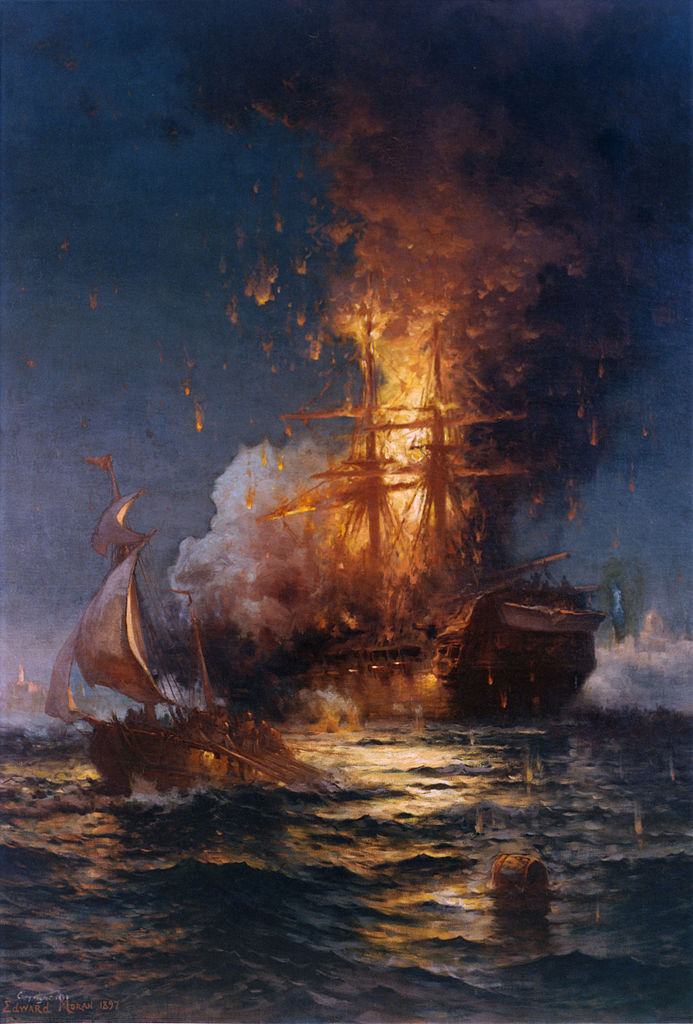
As said above Frigates were “rogue ships”, used mostly as privateers. They preyed on shipping, with a crew motivated mostly by the prize, as well (and even more) their captain, often young. Bold aggressiveness and seamanship made Frigates a well appreciated school for young officers, before joining larger ships of the line. So there was some rivalry between these young officers to obtain command of such ships. Fast, well armed, free to roam the seas at will, they sometimes bring these officers a tremendous wealth, in addition to fame and recognition by other officers ad the admiralty, the perfect jump to a large 1st or 2nd rate man-o-war by age 30-40.
In one occasion, two British captains battled and captured two Spanish vessels, loaded with gold and silver. The prize was so enormous it represented 500 years of wages for both officers in one lucky swoop. However all Frigate captains were not so fortunate. Greed pushed also some to attack much larger ships as corsairs and privateers do, and lost.
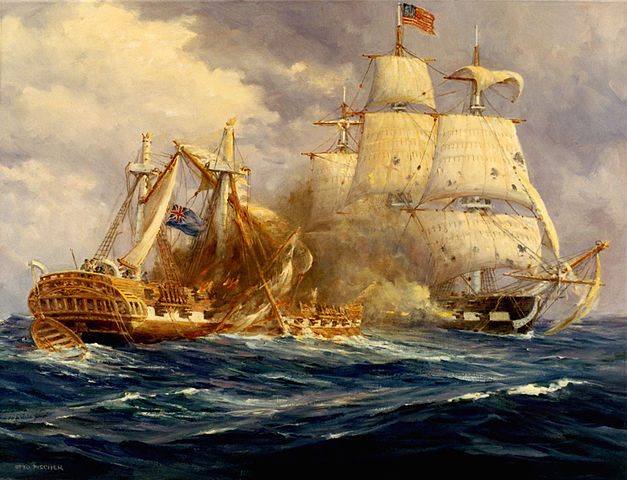
USS Constitution vs Guerriere
Tactics-wise, these lone Frigates used all manoeuvres in the book to secure victory. Perfect knowledge of the wind to choose the right course, using all surface sail available (like using studding sails, stunsails) “even the handkerchiefs” when there was insufficient wind to close the distance, using both rigging and rudder to break speed and manoeuver quickly around another ship, were all used in order to bring the broadside to bear at the right distance. It was often judicious sometimes to wait at the last moment to fire at the perfect angle, often conceding a volley from one’s enemy, and the ideal distance was rather close given the poor accuracy and muzzle velocity of the bronze cannons of the time.
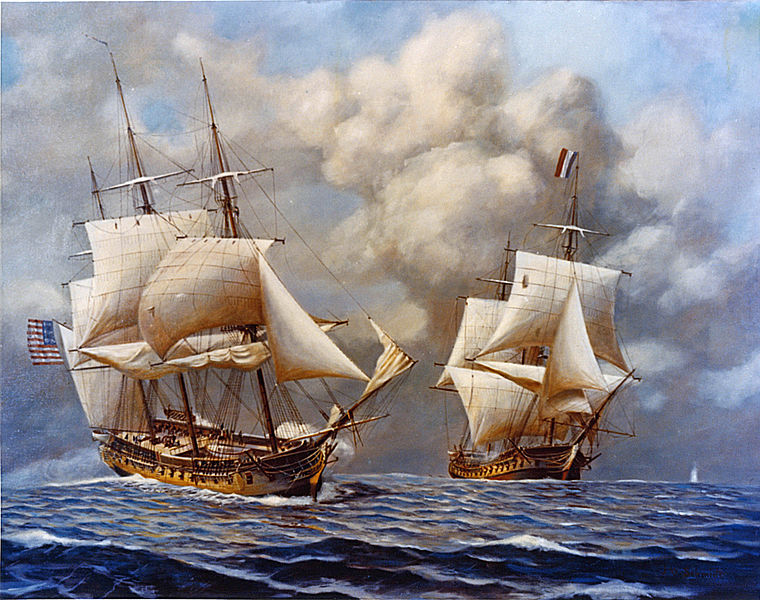
Ships pounded themselves at 50 meters (54 yards), then either manoeuvre to present the other broadside or close in even further to board the enemy ship, with swords, pistols and hand grenades, while musketeers often sniped from the fighting tops or marine troops volley-fired from the deck. One particularly praised manoeuvre of the time was to broadside the stern of the enemy ship: There were there only glass and flimsy wooden work of the officers “castle” there. Balls flew freely for the entire length of the deck, creating mayhem in the process. This was often seen as the coup de grace for a ship already crippled.
There were at least four gunnery options at that time:
-The classic shot: Solid balls which penetrated wooden walls, spraying large quantities of wood splinters in the process, injuring the crew.
-The incendiary shot: The same balls were white-heated in the onboard furnace. They were designed to set fire to the enemy ship. With some luck, one could hit a powder bag, or better, roll into the gunpowder magazine. On these wooden vessels with large quantities of explosives, tar and sails this meant hell in a short while. Of course this was mostly a radical tactic, without regard to the capture of the ship.
-The chained shots: More complicated to operate and requiring more powder, the exercise consisted in loading a barrel with two chained balls which spinned at great speed, cutting ropes, masts, trunks and legs indifferently.
-The canister shot: Also well known on land battles, these were packets of small lead bullets sprayed at will often from the upper deck’s smaller guns before boarding.
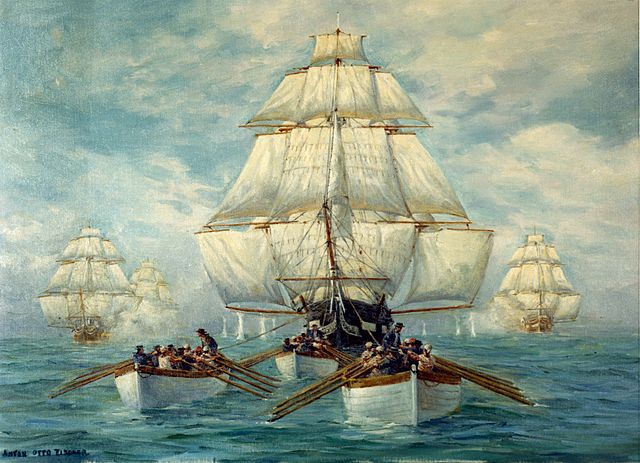
However, when committed as 5th-rate warships alongside the battle-line they were used mostly as dispatch vessels amidst the smoke of war, behind friendly lines, or salvaging sailors of sunken ships, preventing the enemy to escape, or spotting a possible reinforcement.
The last sailing Frigates (1850-1880)
The era of the American “super frigates” left a strong impression on naval construction during the post-Napoleonic era. Their influence started with the construction and invention of the Schooners, veterans of the 1912 war when they were pitted against the strongest navy on the globe. They were quickly overshadowed by the much larger Frigates of the Constitution class as seen above.
It should be noted that what was called the “Blackwall Frigates” (1840-1875) were in fact brand new, fast Indiamans copying the hull of Frigates, which were born when the ancient East India Company ceased activities in 1833, while the first steamshp line opened in the Atlantic in 1838. The first of these new generation trade sailships were built at Green & Wigham, Blackwall, hence the name. This was the 818 t. Seringatapam (1837). She was followed by many others under the same name but not necessarily at Blackwall until the Superb (1866) and Melbourne (1875) by the same Green yard but with an iron hull.
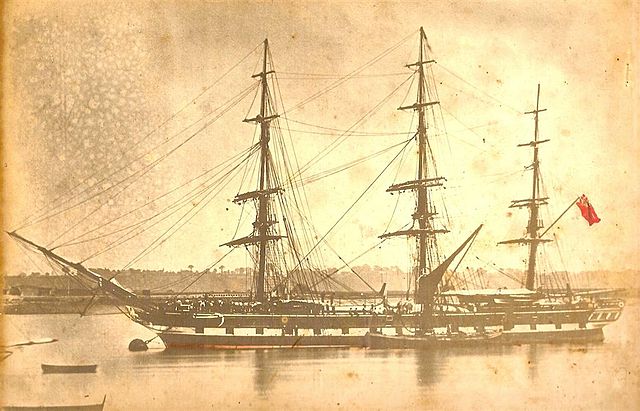
None were armed despite the name, but they were decorated with fake ports lines in intimidate possibly bad encounters on their way to India. They disappeared, condemned by the sheer speed of the Clippers. Another influence on late sailing frigates were the “clippers of baltimore”, schooners with very fine lines and which passed for the fastest sailing ships of their time, but perhaps one-masted pilot cutters. The hul shape was not only influential on the first whalers, but clippers as well and unfortunately… slave ships. Many were used for war, with a light artillery on their open deck.
The “last classic Frigates” were sailing frigates in service around the world in 1860, just when there was a revolution of steam and iron, with many conversions to steam and the first sea-going ironclads.
In the Royal Navy, there were ten sailing ships of the line in the effective list, about 25 not on the effective list, including four in steam conversion, but also 28 screw frigates and, for what we are concerned, 5 sailing frigates in the effective list and 49 not in the effective list. They were reduced to harbour duties, of the 4th and 5th rank, ranging from 36 to 60 guns (HMS Jupiter) showing the American “super frigate” concept had a strong influence of shipbuilding in traditional sea powers;
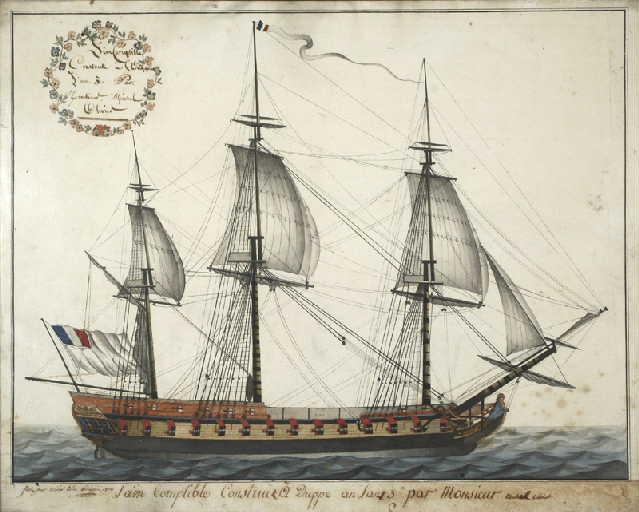
French revolutionary wars Frigate L’Incorruptible (after Robespierre), 1795.
In the French Navy
The eternal rival of the Royal Navy was faster in recent years delivering a large steam ship-of the line (Le Napoléon) in 1855 and first sea-going Ironclad in 1859, Gloire, by the same engineer. There were 16 screw frigates in active service (36 ot 56 guns) and 19 smaller paddle frigates, but sailing frigates were however still string in the navy’s lists with 27 vessels, generally of the 52 guns type, conceding quite a large advance to the British fleet.
In the US Navy (‘Old Navy’)
Just before the start of the civil war, the Union fleet counted seven screw frigates and three side-wheeled frigates, but also 15 sailing frigates (including the 1797-98 ones), large corvettes and three razeed ones (see later).
In the Russian Navy
Nine screw frigates were in service or in completion in 1860, seven paddle frigates, and five sailing frigates. The type was retired for good in 1862 or converted (like the Castor).
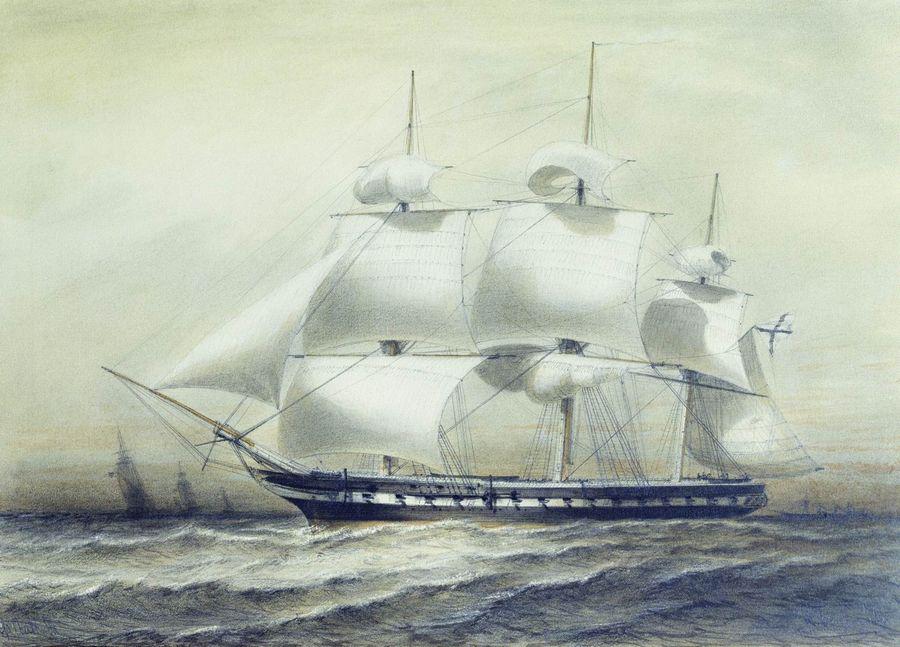
Russian Frigate Pallada
Other fleets:
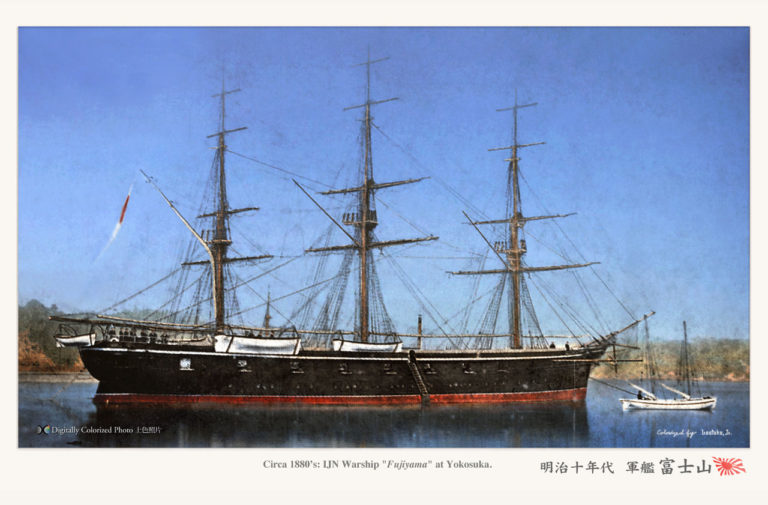
Japan was force-opened in 1853 (Commodore Perry) and the new Meiji government was keen on modernizing the fleet by swapping directly to the steam screw type Frigate; They were hardly-pressed during the Boshin war. The best known sailing frigate of the time was the US-built Fujiyama (1863).
Austria-Hungary had only three 50 guns screw frigates and a single ship of the line, the Kaiser. However in construction were the Novara, Schwarzenberg, Radetzky, Adria and Donau.
Prussia had two sailing frigates (Gefion and Thetis), but was building the five Arcona class screw frigates from 1855.
Italy, on the verge of unity had 9 frigates (screw ) including four in construction and three sailing only at the eve of the Battle of Lissa.
Turkey had a still significant battle fleet in 1860, despite crippling losses at Navarino (1827) and at Sinope in 1853, showing the extremely efficient Paixhans guns at work, the Turkish Ottoman authorities tried to revitalize and modernize the fleet, around 20 sailing Frigates were in service, including four screw frigates.
Sweden has about 11 sailing frigates, Denmark has two 42 guns screw frigates, and about 25 sailing ones (including those of the Royal Dano-Norwegian Navy). The Dutch Fleet had three screw frigates (two more in completion), and around seven sailing frigates (32 and 52 guns) in 1860. Portugal had two recent screw frigates (and two sailing ones), all modest. Spain, which quickly converted frigates to ironclads, had three screw frigates (two more in construction) three paddle frigates. Five more screw frigates will be built in the 1860s. Greek Navy was dwarved by the Turkish Ottoman Navy, with just a 26-gun sailing “frigate” among other vessels. Imperial China had virtually no modern frigates, only the paddle frigate Chiangtzu (1863) was refused and resold to the Daimyo of Satsuma, and two screw Frigates were built in 1872. Brazil in 1860 had just one single sailing frigate, just as Peru.
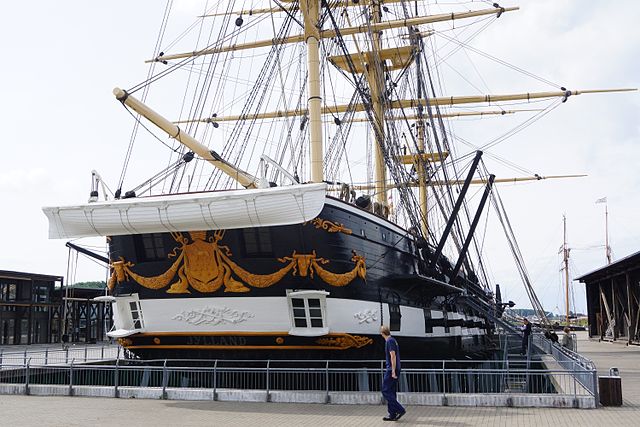
Stern view of the Danish steam Frigate Jylland (1860), now preserved at Ebeltoft.
About the Razee
These particular ships emerged after the Royal Navy had to deal with the American 44-guns Frigates during the 1812 war. Being outmanoeuvred, outgunned, this went as far as the interdiction of one-on-one duels between British and American Frigates. Building new Frigates takes time (years in order to leave the wood drying), so in the meantime, British engineers devised an ingenious shortcut, trading speed for firepower and protection: They created “heavy frigates” by scalping the upper deck of a 4th or 3th rank ship of the line, called Razee.

USS Cumberland (1824) after conversion as a razee in 1855–1857. She was classed as a “sloop-of-war” because of fewer guns, firing heavy or exploding shells. The conversion made her a more stable, faster platform.
In practice, this created a lower, more agile vessel, more capable of engaging frigates on their own. Yet by their two complete artillery decks with heavy guns they outmatched the American firepower, and retained the very thick walls of the original ship of the line, making them impervious to the super-frigates fire. These Razeed ships in fact were much older than the war of 1812. Called “razee” because of their razeed upper deck they were built already in 1794, and another wave for 22 in total towards the end of the Napoleonic wars. The French revolutionary government in turn started to convert ships of its own, seven ships in all started in 1794. On the US Navy, the USS Independence of 1814 was also converted. Of course they were all obsolete when the new generation of super-frigates of 55-60 guns started to appear. With their heavier broadside and reinforced protection they renewed the park of warships.
Famous Frigates
Here is a work in progress which will be completed over time, with Frigates still in existence today (which can be visited), or past Frigates that were a landmark in naval history.
Shtandard (1703)
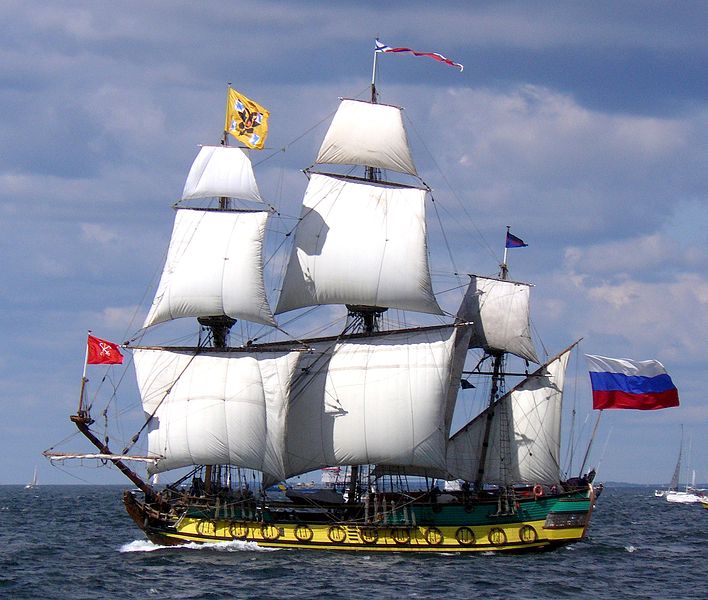
The replica of the first ship of Russia’s Baltic fleet ordered by Peter the Great. A 24-gun Frigate replica made 1999, she is still a familiar sight in tall ships yearly events. She is a good example of an early frigate, influenced by English and Dutch shipbuilding schools. She is now based in St Petersburg.
HMS Surprise (Rose) 1757
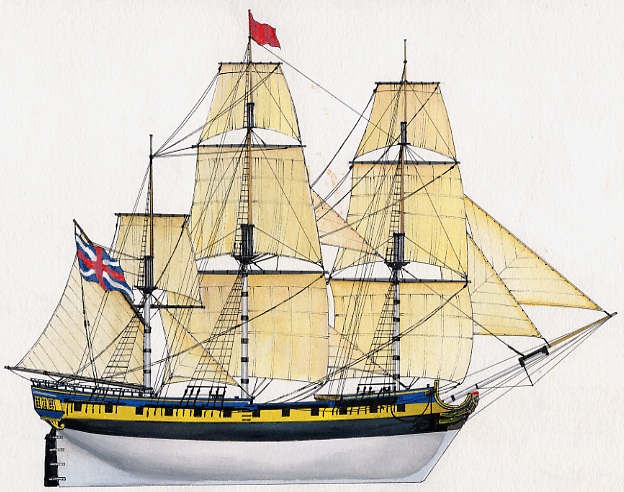
HMS Rose, a typical 1780 British Frigate captured during the war of 1812. This famous seaworthy replica, accustomed to all tall ships events since 20 years has been notably used a “hms surprise” in the “master and commander” movie derived from the same name novels (Author’s painting)
She was a small 28-guns sixth-rate replica by Phil Bolger of a 1757 ship, of the early “French type” frigate. She was used in movies such as “The Man Without a Country”, “Master and Commander”, or “Pirates of the Caribbean: On Stranger Tides”. She belongs now to the Maritime Museum of San Diego.
Frederick H. af Chapman’s Frigates of the Archipelago (1780)
Hemmemaa with latin rig (1781)
The Hemmemaa was the first, largest and most distinctive “frigates of the archipelago” designed by famous naval architect Frederick af Chapman. They were tailored to replaced classic sailing frigates which draught was impossible for Baltic shoals. It gave an edge to the Swedish fleet during the Second Northern war. Meawnhile the Russians launched dozens of Galleys. The Battle of Hoglund, battle of Svenska Sund were massive clashes pitting both types of ships.
L’Hermione (1779)
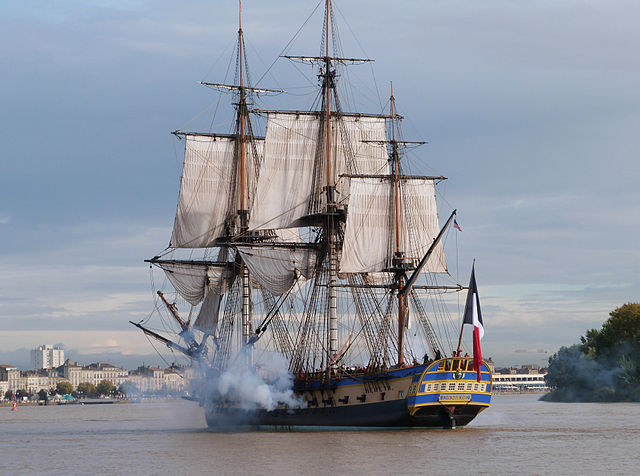
French Frigate built in Rochefort she was replicated in 1997-2014 and made a tour of the USA, as the ship which originally carried Marquis de Lafayette to the Gen. Georges Washington, bringing the news that the French army was coming. The original, a 32-guns Concord-class ship fought at the battle of Louisbourg (1781) but was wrecked in 1793.
USS Constitution (1797)
What a legend… Preserved today as the last warship in service worldwide, the USS Constitution is the last of the famous 44-gun “super-frigates” developed to deal with far away American assets and trade. They served extensively in the quasi-war with France, capturing or destroying dozens of French privateers and won many duels with British Frigates, to the point the latter avoided them whenever possible. USS Constitution, nicknamed “old ironsides” as her tightly packed sections made lead balls bounce or stay embedded. She won famous duels like with the Guerriere, Java, captured HMS Cyane and forced HMS Levant to flee. This was only the 1812 war. She will serve, modernized, during the civil war, and started a career as a museum ship in 1900, completely rebuilt in her original state in 1925, 1970 and 1995. She is now the best sea-going ambassador of the US Navy’s tradition worldwide as official flagship. She is also the second oldest commissioned warship in the world, and the oldest commissioned warship afloat.
HMS Trincomanlee (1817)
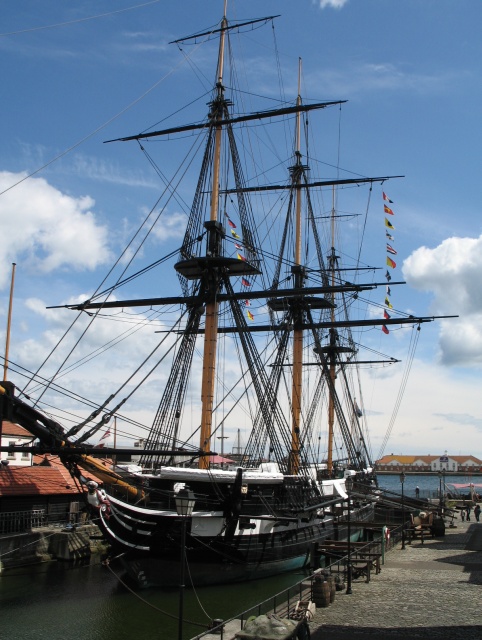
A 46 guns (with 14 carronades) frigate she was a perfect example of the experience accumulated during the Napoleonic war, one of the many Leda class ships. Built in Bombay, she served until 1857, was renamed Foudroyant 1903 as a training ship and later was restored and is now on display at Hartlepool. The sole other example of the same class, HMS Unicorn (1824) is now in Dundee, Scotland.
La Belle Poule (1834)
One of the finest French Frigate of the time, she was deigned by J.M. Sané on carefully laid plans, using the latest mathematical principle to shape her hull lines and construction strength. She was in essence a French replica to the American “super-frigates” but integrating all the latest advanced of the time. Carrying 60 guns on two artillery decks she was as fast, yet more agile. She could turn faster and on a tighter space due to a well-studied hull shape and rudder. She was sober, yet with a roomy officer “castle”, and continuous walls, a very elegant, black ship. The name, used for the fourth time in the Navy, was inherited from the most gorgeous woman of her time, according to Francis the 1st, which called her “La Belle Paule”, corrupted by a chronicler into “Poule”, so literally “the nice hen”. She bring back the remains of Napoleon from Saint Helena, served in Canada, the Mediterranean, and the Crimean war before being decommissioned in 1866.
Dom Fernando II e Glória (1843)
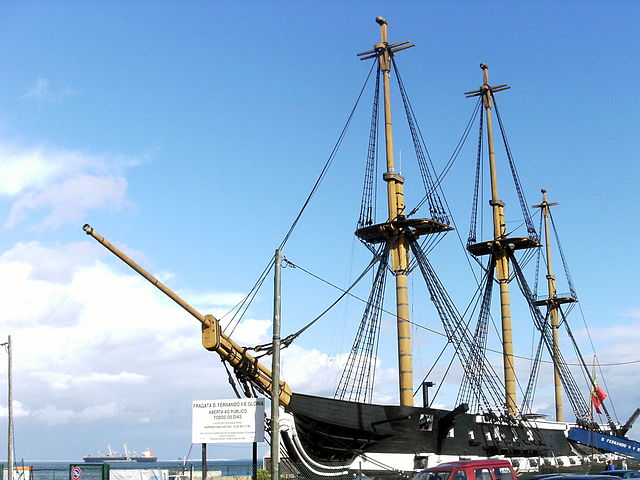
Dom Fernando II e Glória, a 50-gun sailing frigate, now preserved in Almada, Portugal. She was originally first thought in 1821 for the Portuguese colony of Daman in India and was fully restored in 1990. This is one of the very last sailing Frigates, an idea of the Intendant of the Royal Portuguese Navy of Goa, Cândido José Mourão Garcez Palha. He proposed the construction of a frigate tailored to protect the colony of Daman and made with teak wood from the large forest in Nagar-Aveli. Authorization was given in 1824 by king João VI. Both civil war and linked economical problems back in the homeland, delayed the construction over the time. At last it was undertook by the naval engineer Gil José da Conceição, and built by Portuguese and Indian workers, launched in 1843, towed to Goa for fitting out and rigging. Her name was honoring the king consort of Portugal Ferdinand II, and was noted at the time for her spacious accommodations, firt for long range trips and patrols.
She made her maiden voyage on 2 February-4 July 1845 under Captain Torcato José Marques between Goa and Lisbon and was used to transporting troops and their equipments, settlers, colonial administrators or even convicts, banish to far way colonies. In 1852 she carried the Empress consort of Brazil Amélie of Leuchtenberg and her daughter Princess Maria Amélia of Brazil to Madeira. This was attempt to cure the tuberculosis of the latter, in vain. The Frigate Dom Fernando II e Glória also carried the explorer Portuguese explorer António da Silva Porto and his team to Angola in 1854, in order to make the first crossing of Africa, from Angola to Mozambique. In 1855, May, she served as the flagship of a naval force based in Ambriz, Angola, to support actions against a local rebellion. She also helped colonizing Huíla in Angola in 1860, carrying sheeps and horses from South Africa.
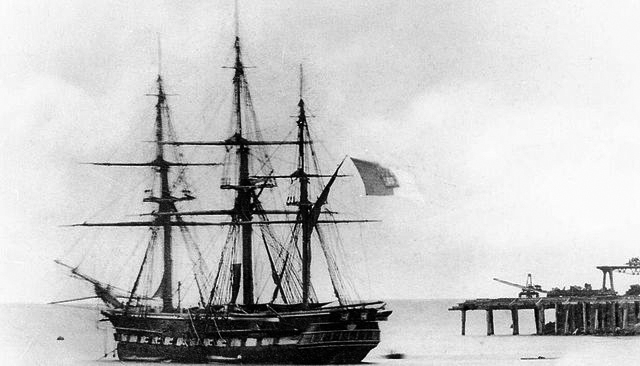
In 1865, she replaced the old Vasco da Gama as the main fleet gunnery Schoolship, a role she kept until 1878. She then departed for her last training mission to the Azores, rescuing en route the crew of the American barque Lawrence Boston. She returned in Lisbon, only to be moored permanently at the Naval Artillery School. In 1889 her masts were cut down and two redoubts fitted with modern cannons were installed as she continued to serve as an artillery ship, surviving until 1938. She was then the flagship of the river Tagus’s fleet.
Two years after as WW2 broke out, she was at last considered unfit for naval service. She housed from then on the social institution Dom Fernando, for general education and teaching seamanship to underprivileged youth. She kept this role until 3 April 1963, as during a routine maintenance a fire erupted that partially destroying her hull. She was later towed in a desolated place on the Tagus and left there to rot, half buried in the mud-flats for 29 years. Until it was decided to restore her by the National Commission for the Commemoration of the Portuguese Discoveries . She started a new career, ongoing until now, of museum ship on 12 August 1998 after full restoration, in Almada. In 22 years she will be 200 years old.
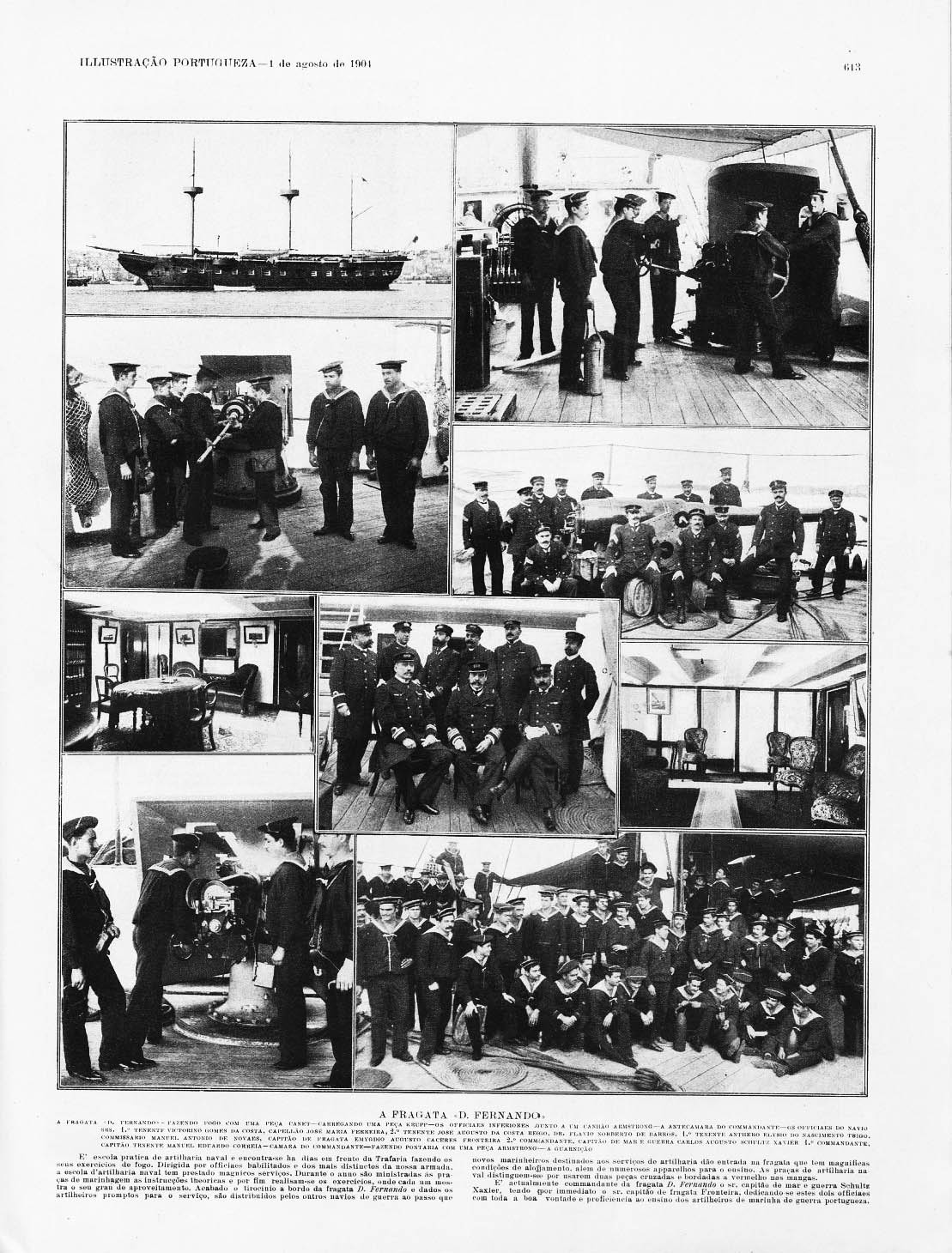
Dom Ferdinand II as an artillery schoolship 1904
HNLMS Bonaire (1877)
A Dutch steam Frigate, without a particularly famous history, but which is preserved today in the Netherlands and therefore is in the process of being re-opened to the public. HNLMS Bonaire was launched on 12 May 1877 (At Fijenoord arsenal?) and completed at the end of the year. She was built as a 3-masted barquentine, displacing 837 long tons deadweight, for a length of 53 m (173 ft 11 in), a beam 9 m (29 ft 6 in) and draught of 3.9 m (12 ft 10 in). She was armed by one 15 cm BL gun, three 12 cm BLs orientable on the deck, two 3.7 cm turret gun, and a 120 cm mortar plus various lighter boat guns.
This screw-powered steamship of the fourth class is nonetheless the oldest remaining Dutch naval vessel built in the Netherlands, from Rotterdam, to be exact from the Nederlandsche Stoomboot Maatschappij. Its steam engine iconsisted of two Scottish boilers and a two-cylinder steam piston machine.
By 1877, iron-plated hulls or iron hulls were now common, and the Bonaire’s iron hull was backed by teak beams. This woodwork was als there for fixing zinc plates, to preventing fouling. This did not worked well, however the zinc plates acted as a cathodic protection for the iron ship’s skin, preventing corrosion.
In her active life, she was deployed abroad, making a few trips to the Caribbean and firing shots against pirates from Venezuela and Colombia. In 1902 the Dutch Frigate was worn out and obsolete and she was taken out of service and converted into a lodging ship. She was next based in Hellevoetsluis and Dordrecht until 1923 and later sold to the municipality of Delfzijl. The latter used her until 1988 as a lodging ship for the Abel Tasman shipping school. The HLNMS Bonaire has been the host of Den Helder since 1996, and has been taken in hands for a full restoration in a dock since 2005.
Read More about the Bonaire and its restauration project.
Read More/Src
Constam, Angus & Bryan, Tony, British Napoleonic Ship-Of-The-Line, Osprey Publishing
Conway’s all the worlds fighting ships 1860-1905 and:
Gardiner, Robert (2000) Frigates of the Napoleonic Wars, Chatham Publishing
Gardiner, Robert & Lambert, Andrew, (Editors), (2001) Steam, Steel and Shellfire: The Steam Warship, 1815–1905
Gardiner, Robert & Lavery, Brian (Editors) (1992) The Line of Battle: The Sailing Warship 1650-1840
Lambert, Andrew (1984) Battleships in Transition, the Creation of the Steam Battlefleet 1815–1860
Lavery, Brian (1989) Nelson’s Navy: The Ships, Men and Organisation 1793–1815.
Rodger, N.A.M. ((2004)) The Command of the Ocean, a Naval History of Britain 1649–1815
Dictionary of American Naval Fighting Ships (DANFS)
http://www.mandragore2.net/dico/lexique2/lexique2.php?page=fregate
wikipedia.org/wiki/Fredrik_Henrik_af_Chapman
wikipedia.org/wiki/List_of_frigate_classes_of_the_Royal_Navy
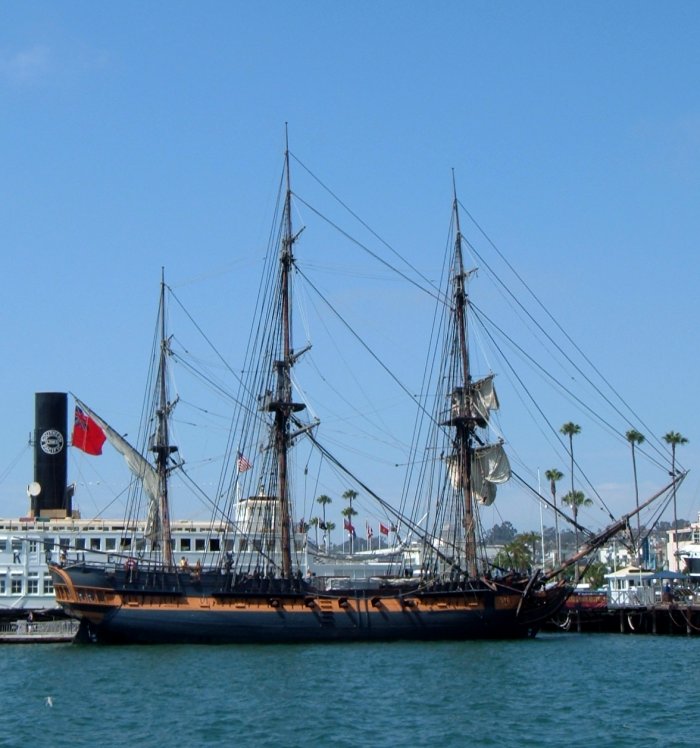

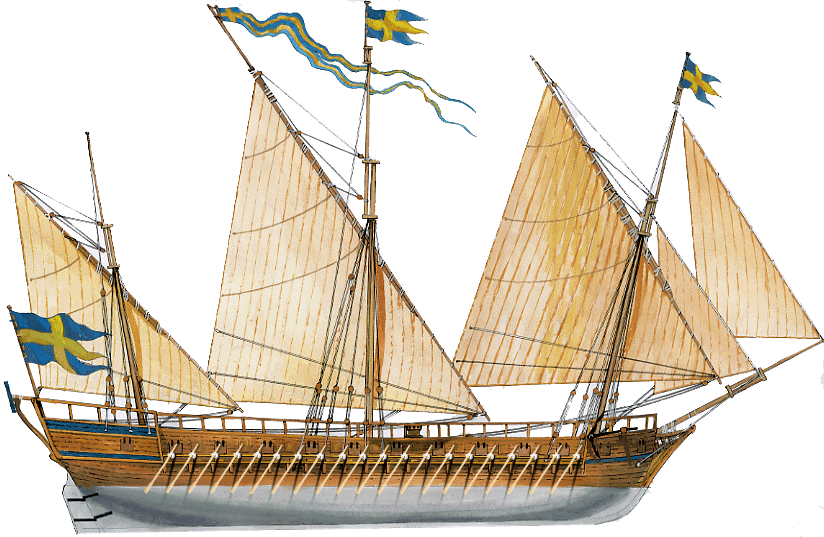
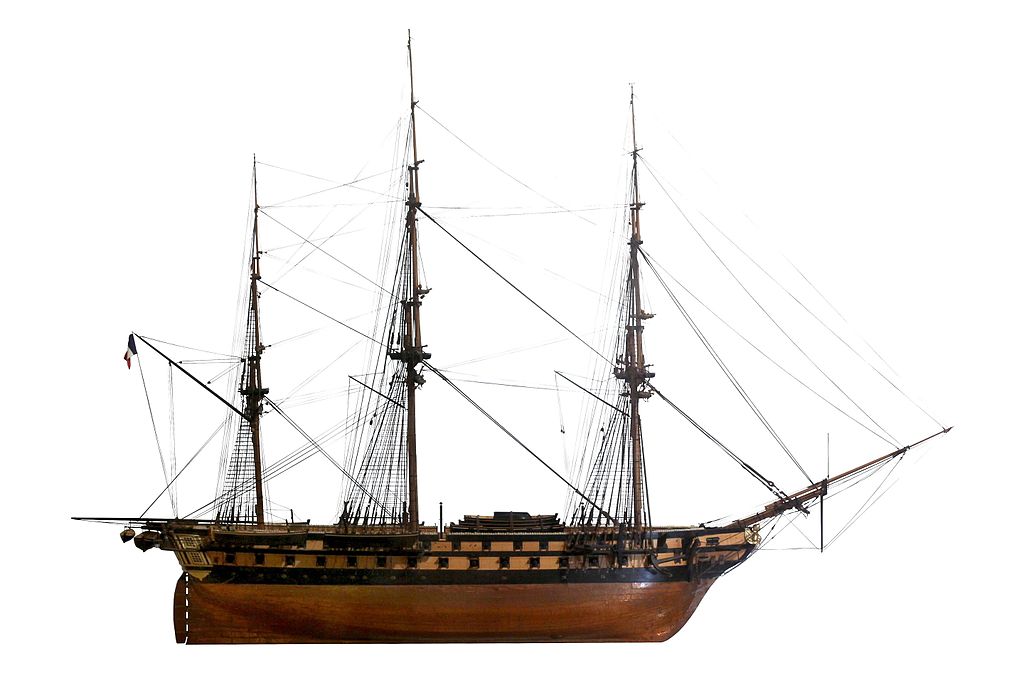
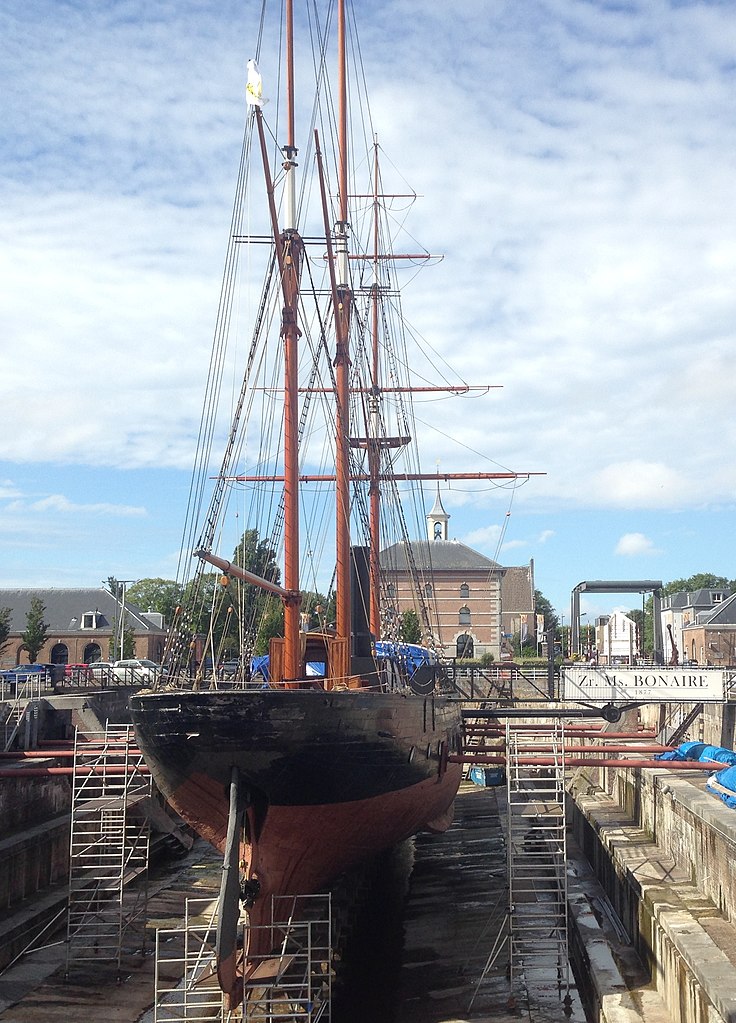
 Latest Facebook Entry -
Latest Facebook Entry -  X(Tweeter) Naval Encyclopedia's deck archive
X(Tweeter) Naval Encyclopedia's deck archive Instagram (@navalencyc)
Instagram (@navalencyc)





 French Navy
French Navy Royal Navy
Royal Navy Russian Navy
Russian Navy Armada Espanola
Armada Espanola Austrian Navy
Austrian Navy K.u.K. Kriegsmarine
K.u.K. Kriegsmarine Dansk Marine
Dansk Marine Nautiko Hellenon
Nautiko Hellenon Koninklije Marine 1870
Koninklije Marine 1870 Marinha do Brasil
Marinha do Brasil Osmanlı Donanması
Osmanlı Donanması Marina Do Peru
Marina Do Peru Marinha do Portugal
Marinha do Portugal Regia Marina 1870
Regia Marina 1870 Nihhon Kaigun 1870
Nihhon Kaigun 1870 Preußische Marine 1870
Preußische Marine 1870 Russkiy Flot 1870
Russkiy Flot 1870 Svenska marinen
Svenska marinen Søværnet
Søværnet Union Navy
Union Navy Confederate Navy
Confederate Navy Armada de Argentina
Armada de Argentina Imperial Chinese Navy
Imperial Chinese Navy Marinha do Portugal
Marinha do Portugal Mexico
Mexico Kaiserliche Marine
Kaiserliche Marine 1898 US Navy
1898 US Navy Sovietskiy Flot
Sovietskiy Flot Royal Canadian Navy
Royal Canadian Navy Royal Australian Navy
Royal Australian Navy RNZN Fleet
RNZN Fleet Chinese Navy 1937
Chinese Navy 1937 Kriegsmarine
Kriegsmarine Chilean Navy
Chilean Navy Danish Navy
Danish Navy Finnish Navy
Finnish Navy Hellenic Navy
Hellenic Navy Polish Navy
Polish Navy Romanian Navy
Romanian Navy Turkish Navy
Turkish Navy Royal Yugoslav Navy
Royal Yugoslav Navy Royal Thai Navy
Royal Thai Navy Minor Navies
Minor Navies Albania
Albania Austria
Austria Belgium
Belgium Columbia
Columbia Costa Rica
Costa Rica Cuba
Cuba Czechoslovakia
Czechoslovakia Dominican Republic
Dominican Republic Haiti
Haiti Hungary
Hungary Honduras
Honduras Estonia
Estonia Iceland
Iceland Eire
Eire Equador
Equador Iran
Iran Iraq
Iraq Latvia
Latvia Liberia
Liberia Lithuania
Lithuania Mandchukuo
Mandchukuo Morocco
Morocco Nicaragua
Nicaragua Persia
Persia San Salvador
San Salvador Sarawak
Sarawak Uruguay
Uruguay Venezuela
Venezuela Zanzibar
Zanzibar Warsaw Pact Navies
Warsaw Pact Navies Bulgaria
Bulgaria Hungary
Hungary

 Bundesmarine
Bundesmarine Dutch Navy
Dutch Navy Hellenic Navy
Hellenic Navy Marina Militare
Marina Militare Yugoslav Navy
Yugoslav Navy Chinese Navy
Chinese Navy Indian Navy
Indian Navy Indonesian Navy
Indonesian Navy JMSDF
JMSDF North Korean Navy
North Korean Navy Pakistani Navy
Pakistani Navy Philippines Navy
Philippines Navy ROKN
ROKN Rep. of Singapore Navy
Rep. of Singapore Navy Taiwanese Navy
Taiwanese Navy IDF Navy
IDF Navy Saudi Navy
Saudi Navy Royal New Zealand Navy
Royal New Zealand Navy Egyptian Navy
Egyptian Navy South African Navy
South African Navy






























 Ukrainian Navy
Ukrainian Navy dbodesign
dbodesign